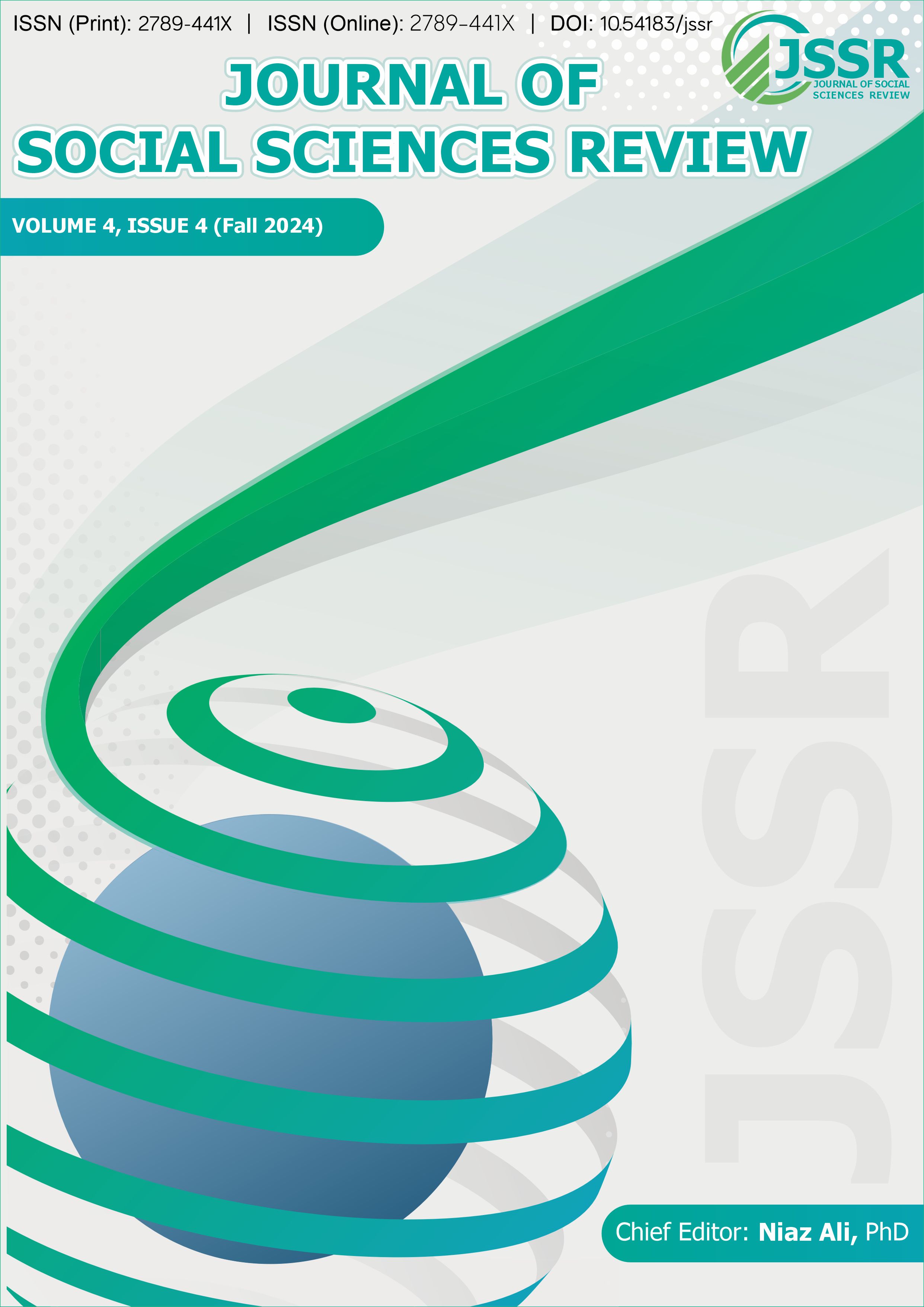Moral Development of Students at Elementary Level: Content Analysis of Islamiyat Textbook Grade VIII
DOI:
https://doi.org/10.62843/jssr.v4i4.448Keywords:
Moral Development, Grade VIII, Islamiyat Textbook, Qualitative Content AnalysisAbstract
The ongoing struggle is crucial to counteract the disintegration faced by many in contemporary society, as well as to eliminate discrimination, racial bias and social inequalities that perpetuate the injustices and inequities characterizing our world. We undertook this study to scrutinize the textbook Islmaiyat’s content, particularly the knowledge and values, for the eighth-grade, with the aim of fostering the moral development of students. Khyber Pakhtunkhwa's Islamiyat textbooks served as the sole focus of the study. This qualitative study employed the interpretive paradigm and utilized content analysis to examine Islamiyat at the eighth-grade level. The researcher utilized Imam Ghazali’s Islamic philosophy and Kohlberg’s moral development theory as the theoretical foundation for this investigation. We gathered data from the Islamiyat textbook for grade VIII in the academic year 2022-23. The researchers manually analyzed the data using content analysis and coding methods. The research pinpointed the themes of moral development that emerged from the contents of textbook Islamiyat grade VIII which were;Quran and Hadiths. These themes encompassed fundamental beliefs, acts of worship, Uswa Hasanah, the importance of global values, Islamic history, and the inculcation of moral values in contemporary society. The study advised revising the textbook to correct certain technical errors and enhance its utility for students' moral development.
References
Alvi, S. T., Khanam, A., & Kalsoom, T. (2020). Document analysis of secondary school curriculum regarding ethical and moral education in Punjab. Global Regional Review, V(I), 191–206. https://doi.org/10.31703/grr.2020(v-i).23
Bhatti, R. (2017). Islamic beliefs in compulsory Islamic studies (islamiyat) and cognitive development: An investigation. (2017). Journal of Education & Social Sciences, 5(1), 3–18. https://doi.org/10.20547/jess0421705101
Creswell, J. W. (1997). Qualitative inquiry and research design: Choosing among five approaches. Sage publications.
Creswell, J. W. (2009). Research design: Qualitative, Quantitative, and Mixed Methods Approaches. SAGE Publications Inc.
Dorough, S. (2011). Moral development. In Encyclopedia of Child Behavior and Development (pp. 967–970). Springer US. https://doi.org/10.1007/978-0-387-79061-9_1831.
Ebrahimi, Mansoureh, & Yusoff, K. (2017). Islamic identity, ethical principles and human values. European Journal of Multidisciplinary Studies, 6(1), 325. https://doi.org/10.26417/ejms.v6i1.p325-336
Elo, S., & Kyngäs, H. (2008). The qualitative content analysis process. Journal of Advanced Nursing, 62(1), 107–115. https://doi.org/10.1111/j.1365-2648.2007.04569.x
Faizi, W. N., Bibi, W., & Khan, F. (2020). Educational policies (1947-2009) of Pakistan and integration of Islamic values among secondary level learners: an evaluative study. Pakistan Journal of Humanities & Social Sciences Research, 3(01), 79-90.
Gichuru, M. J. (2017). The interpretive research paradigm: A critical review of is research methodologies. International Journal of Innovative Research and Advanced Studies (IJIRAS), 4(2), 1–5. https://www.ijiras.com/2017/Vol_4-Issue_2/paper_1.pdf
Hassan, R. (1990). What does it mean to be a Muslim today? New Blackfriars, 71(835), 57–66. https://doi.org/10.1111/j.1741-2005.1990.tb01386.x
Matheson, C., & Matheson, D. (2000). Educational issues in the learning age. A&C Black.
Nucci, L. P. (2001). Education in the moral domain. Cambridge University.
Schuitema, J., Dam, G. T., & Veugelers, W. (2008). Teaching strategies for moral education: a review. Journal of Curriculum Studies, 40(1), 69–89. https://doi.org/10.1080/00220270701294210
Shams, A. (2018). Analysis of the Curriculum of Islamiyat at Primary level in the light of Quran. [MS Education]. International Islamic University Islamabad.
Shams, A., Ajmal, F., & Jumani, N. B. (2021). Effectiveness of Mobile Learning for Academic Progress of MS Education Students: A Case Study of Distance Learning Program at IIUI. Pakistan Journal of Distance and Online Learning, 7(1), 33–46.
Siddique, S., & Khawaja, F. (2021). Exploring Education for Global Citizenship: Qualitative Content Analysis of Islamiyat Textbook. Pakistan Social Sciences Review, 5(4), 470-482. https://pssr.org.pk/issues/v5/4/exploring-education-for-global-citizenship.pdf
Thakur, I., Akbar, H., Fatima, H. G., & Akram, K. (2022). FACTORS AFFECTING EFFECTIVE TEACHING OF ISLAMIYAT ON SPIRITUAL AND MORAL DEVELOPMENT OF STUDENTS AT SECONDARY LEVEL IN PUBLIC SCHOOLS OF LAHORE, PAKISTAN. Journal of Arts & Social Sciences, 9(2), 50-60.
Thanh, N. C., & Thanh, T. T. (2015). The interconnection between interpretivist paradigm and qualitative methods in education. American Journal of Educational Science, 1(2), 24–27.
Williams, H. (2021). The meaning of “phenomenology”: Qualitative and philosophical phenomenological research methods. The Qualitative Report. https://doi.org/10.46743/2160-3715/2021.4587
Woolfolk, A. (2006). Educational Psychology. Pearson Education in South Asia.
Zaveri, S. (2016, November 5). Moral Development in children. Psychology Discussion - Discuss Anything About Psychology; PsychologyDiscussion.net. https://www.psychologydiscussion.net/psychology/moral-developmen-in-children-psychology/2441
Downloads
Published
Issue
Section
License
Copyright (c) 2024 Copyright in the Journal of Social Sciences Review is retained by the author(s). Authors also grant any third party the right to use the article freely as long as its integrity is maintained and its original authors, citation details and publisher are identified.

This work is licensed under a Creative Commons Attribution-NonCommercial 4.0 International License.
SSR's Editorial Board shares the vision of providing free access to information, education, and science for everyone, thus promoting its content through an OPEN ACCESS POLICY, fulfilling the DOAJ definition of open access. The JSSR adheres to an Open Access and Copyright Licensing Policy based on the belief that making research freely accessible to the public promotes greater global knowledge sharing.
The JSSR uses the Creative Commons Attribution-NonCommercial 4.0 International License. The authors who apply and publish in JSSR consent to abide by the copyright policy set out in the Creative Commons 4.0 license (Attribution-NonCommercial 4.0 International license).
- Copyright in the Journal of Social Sciences Review is retained by the author(s).
- Authors also grant any third party the right to use the article freely as long as its integrity is maintained and its original authors, citation details and publisher are identified.
While "By 'open access' to this literature, we mean its free availability on the public internet, permitting any users to read, download, copy, distribute, print, search, or link to the full texts of these articles, crawl them for indexing, pass them as data to software, or use them for any other lawful purpose, without financial, legal, or technical barriers other than those inseparable from gaining access to the internet itself."



